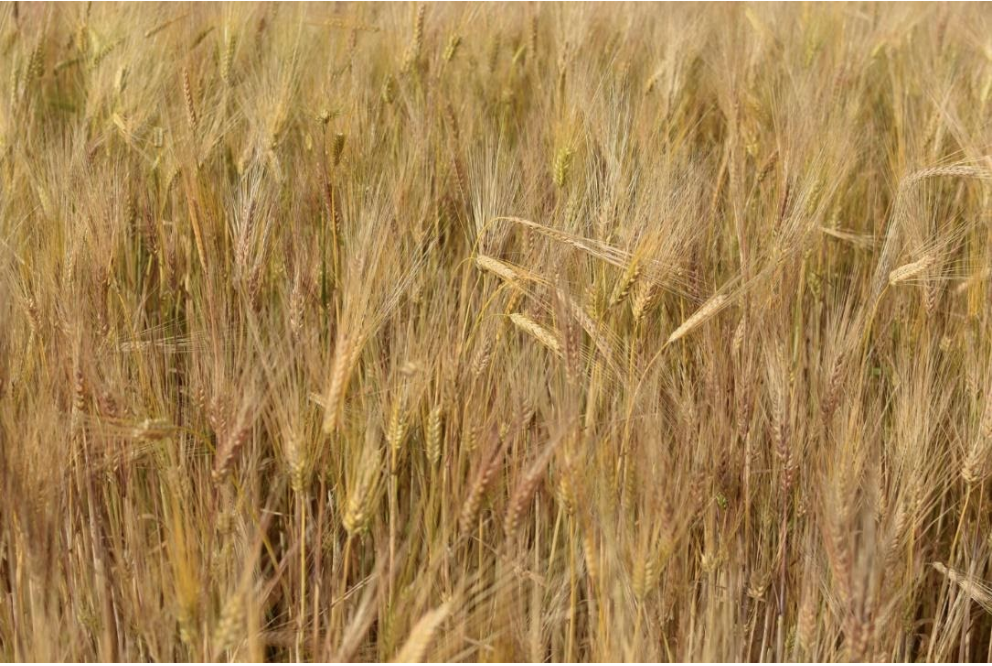Crop: Hordeum vulgare L. (Barley)
In 1997, Dipartimento di Scienze Agrarie, Alimentari e Ambientali of University of Perugia (DSA3_UNIPG) produced a barley Composite Cross derived Population (CCP, named AUT DBA) by crossing seven different Parental Populations (PPs) (Raggi et al. 2016a) derived from crosses of cultivars, landraces and promising lines, that were good performers under low-input conditions in Central Italy (Negri and Petti 1995). The PPs were selected to combine different sources of adaptation and resistance to biotic and abiotic stresses and represented a large array of germplasm of diverse origin (Raggi et al. 2016b). The population was multiplied in the DSA3_UNIPG experimental field (latitude 43°02’38.41’’ N, longitude 12°25’00.56’’ E, elevation 174 m a.s.l.) for 13 consecutive years consistently in dense sowing (350 seeds m-2), without artificial selection, under a low-input management system (i.e. approximately half of the normal nitrogen supply).
In 2010, UNIPG_DSA3 developed a new population by mixing an equal number of seeds harvested on 48 individual plants of AUT DBA selected according to different morpho-physiological traits (i.e. days to heading, plant height, kernel weight and yield) (Raggi L. personal communication).
A new population (i.e. line mixture), named Mix48, was then developed by mixing the highest yielding and the most diverse lines. Mix48 is composed by two row and six rows lines.
Cultivation System: organic conditions.
Geographical Information
Country: Italy
Mix48 is conserved on farm at the experimental station of DSA3_UNIPG located in Sant’Andrea d’Agliano (Perugia, Italy).
Farmer(s) description:
Mix 48 seed is yearly reproduced by the DSA3_UNIPG in large stands and dense sowing under low input conditions without artificial selection, under a low-input management system (i.e. approximately half of the normal nitrogen supply). This allows its continuous matching variable biotic and abiotic stress and, consequently, its constant evolution.
Considering that genotypes composing Mix48 have been exposed to local selection pressures since years, this population largely mimics a barley landrace and could be considered a ‘reconstructed landrace’.
Propagation system: Seed, self-pollination
Multiplication procedures and consequences on landrace diversity:Mix 48 seed is yearly reproduced by the DSA3_UNIPG in large stands and dense sowing under low input conditions without artificial selection, under a low-input management system (i.e. approximately half of the normal nitrogen supply). This allows its continuous matching variable biotic and abiotic stress and, consequently, its constant evolution.
Considering that genotypes composing Mix48 have been exposed to local selection pressures since years, this population largely mimics a barley landrace and could be considered a ‘reconstructed landrace’.
Management plan existence:The landrace management relies completely on farming activities carried out by DSA3_UNIPG.
Added Values
Currently, DSA3_UNIPG sells Mix48 seed under the frame of COMMISSION IMPLEMENTING DECISION of 18 March 2014 (see details under ‘Access to Resource’). Seed request mostly come from organic farmers seeking for ‘diverse’ materials that can suit their low input, often variable cultivation environments. It is difficult to foresee which will be its future market, initial data are encouraging.
Farmers mostly cultivate Mix48 for feed use, some are experimenting the population for other purposes (beer).
Others (e.g. commercial/geographical brands or special traits):Several experimental activities were carried out by DSA3_UNIPG to assess potential performances of Mix 48 and to consequently promote its use.
Multi-environmental trials carried out in low input and organic systems for four successive years with controls by DSA3_UNIPG, showed that Mix48 population often out-yielded lines recently developed for ‘conventional’ management and showed higher stability. As such Mix48 was recommended for use in Central Italy under organic and low-input management systems.
Presently DSA3_UNIPG is also evaluating the suitability of Mix 48 in the production of beer (chemical characteristics, malting ability and taste of the beer obtained from it.
Studies on Mix48 were partially funded by Strategies for Organic and Low input Integrated Breeding and Management’ (SOLIBAM) project, European Community’s Seventh Framework Programme, [GA n. 245058] with a grant headed by Professor Valeria Negri (DSA3_UNIPG).
Accessions of ‘Mix48’ emmer wheat are also kept, under long terms storage conditions in the germplasm bank of DSA3_UNIPG (FAO ITA-363).
Being multiplied by a Public Body, without high costs, it is feasible that Mix48 will continue to be maintained in situ for a long period.
In order to provide farmers with this genetic resource, DSA3_UNIPG sells Mix48 seed under the frame of COMMISSION IMPLEMENTING DECISION of 18 March 2014 ‘on the organisation of a temporary experiment providing for certain derogations for the marketing of populations of the plant species wheat, barley, oats and maize pursuant to Council Directive 66/402/EEC’ (see https://eur-lex.europa.eu/legal-content/EN/TXT/HTML/?uri=CELEX:32014D0150&from=DA), since 2017
Case study prepared by Dipartimento di Scienze Agrarie, Alimentari e Ambientali (DSA3), Università degli Studi di Perugia (UNIPG), Italy.
Most of updates have been communicated by Prof V Negri (DSA3, Univerità degli Studi di Perugia).
- Negri V, Petti R (1995) Fonti germoplasma non adattato per la selezione di varietà adatte all’agricoltura biologica: il lavoro dell’Istituto di Miglioramento Genetico Vegetale di Perugia sull’orzo. In: Santucci F, Zanoli R (eds) Convegno Agricoltura Biologica in Italia: Aspetti Tecnici, Economici e Normativi. Centro Stampa Consiglio Regionale delle Marche, Ancona, Italy, pp 185–196
- Raggi L, Ceccarelli S, Negri V (2016a) Evolution of a barley composite cross-derived population: an insight gained by molecular markers. J Agric Sci 154:23–39. doi: 10.1017/S0021859614001269
- Raggi L, Negri V, Ceccarelli S (2016b) Morphological diversity in a barley composite cross-derived population evolved under low-input conditions and its relationship with molecular diversity: indications for breeding. J Agric Sci 154:943–959. doi: 10.1017/S0021859615000921
